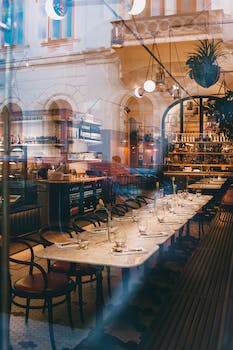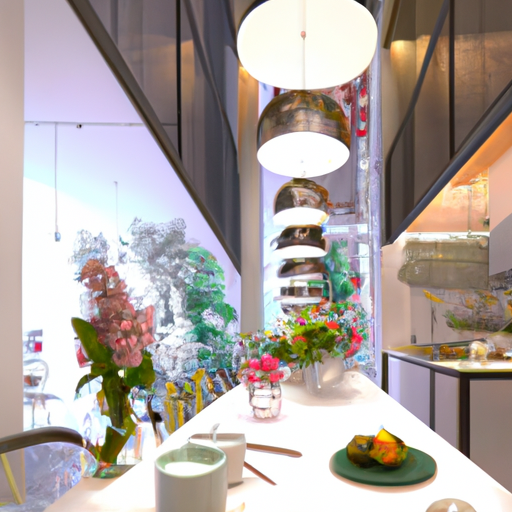Incorporating Opulent Materials and Finishes in Architectural Design
Creating a luxurious atmosphere through architecture is an art that requires a keen eye for detail, a deep understanding of materials, and a strong sense of design. One of the most effective ways to achieve this is by incorporating opulent materials and finishes in architectural design. These elements not only add visual interest and texture to a space, but they also evoke a sense of luxury and sophistication that can elevate the overall ambiance of a building. In this article, we will explore some of the key materials and finishes that can be used to create a luxurious atmosphere in architectural design.
One of the most iconic materials associated with luxury is marble. This natural stone has been used for centuries in palaces, temples, and other grand structures, and its timeless appeal continues to make it a popular choice for high-end residential and commercial projects. Marble can be used in a variety of applications, from flooring and wall cladding to countertops and decorative accents. Its unique veining and subtle color variations add depth and character to any space, while its polished finish reflects light and creates a sense of opulence.
Another material that can be used to create a luxurious atmosphere is gold. While it may not be practical or cost-effective to use solid gold in architectural design, gold leaf and gold-plated finishes can be applied to various surfaces to achieve a similar effect. Gold accents can be used sparingly to add a touch of glamour to a space, or they can be used more extensively to create a truly opulent environment. For example, gold leaf can be applied to moldings, ceilings, and other architectural details, while gold-plated fixtures and hardware can add a touch of elegance to bathrooms and kitchens.
In addition to marble and gold, there are many other materials that can be used to create a luxurious atmosphere in architectural design. For example, exotic woods such as ebony, rosewood, and mahogany can be used for flooring, cabinetry, and furniture, adding warmth and richness to a space. Similarly, natural stone such as onyx, travertine, and limestone can be used for countertops, wall cladding, and other applications, providing a sense of timeless elegance and sophistication.
When it comes to finishes, high-gloss lacquer and polished metal are two options that can add a touch of luxury to any space. High-gloss lacquer can be applied to cabinetry, furniture, and other surfaces, creating a sleek and reflective appearance that adds depth and visual interest. Polished metal, on the other hand, can be used for fixtures, hardware, and other accents, providing a clean and modern look that complements a variety of design styles.
In addition to using opulent materials and finishes, it’s important to consider the overall design and layout of a space when creating a luxurious atmosphere. This includes paying attention to details such as lighting, which can have a significant impact on the ambiance of a room. For example, using chandeliers, wall sconces, and other decorative lighting fixtures can add a sense of grandeur and sophistication, while also providing functional illumination.
In conclusion, incorporating opulent materials and finishes in architectural design is an effective way to create a luxurious atmosphere. By carefully selecting materials such as marble, gold, exotic woods, and natural stone, and using finishes such as high-gloss lacquer and polished metal, architects and designers can create spaces that exude elegance, sophistication, and timeless appeal. Additionally, paying attention to details such as lighting and overall design can further enhance the luxurious ambiance of a space, ensuring that it leaves a lasting impression on all who enter.
Integrating Indoor-Outdoor Living Spaces for a Luxurious Ambiance

Creating a luxurious atmosphere through architecture is an art that requires a keen eye for detail, a deep understanding of design principles, and a commitment to excellence. One of the most effective ways to achieve this is by integrating indoor-outdoor living spaces, which not only enhances the overall aesthetic appeal of a property but also provides a seamless transition between the interior and exterior environments. This article will explore the various ways in which architects and designers can create a luxurious ambiance by incorporating indoor-outdoor living spaces into their projects.
The concept of indoor-outdoor living is not new; it has been a popular design feature in many cultures for centuries. However, it has gained significant traction in recent years, particularly in high-end residential and hospitality projects, as people increasingly seek to blur the boundaries between their indoor and outdoor spaces. This trend is driven by a desire for a more relaxed and informal lifestyle, as well as a growing appreciation for the health and well-being benefits of spending time in nature.
One of the key elements in creating a successful indoor-outdoor living space is the use of large, floor-to-ceiling windows and doors that provide an unobstructed view of the outdoors. This not only allows for an abundance of natural light to flood the interior spaces but also creates a visual connection between the two environments. In addition, the use of high-quality materials, such as glass, steel, and wood, can further enhance the luxurious feel of the space and provide a sense of continuity between the indoor and outdoor areas.
Another important aspect of integrating indoor-outdoor living spaces is the careful consideration of the surrounding landscape. This involves designing the outdoor spaces in such a way that they complement and enhance the architecture of the building, rather than detracting from it. This can be achieved by incorporating elements such as water features, sculptures, and carefully selected planting schemes that add visual interest and create a sense of harmony between the built and natural environments.
In addition to the visual connection between the indoor and outdoor spaces, it is also essential to consider the functional aspects of the design. This includes ensuring that there is a seamless flow between the two areas, with easy access to both the interior and exterior spaces. This can be achieved by incorporating sliding or folding doors that can be opened up completely, creating a large, open-plan living area that extends out onto a terrace or garden.
Furthermore, the choice of furniture and furnishings plays a crucial role in creating a luxurious atmosphere in indoor-outdoor living spaces. High-quality, comfortable, and stylish furniture that is suitable for both indoor and outdoor use is essential, as it not only adds to the overall aesthetic appeal of the space but also ensures that the transition between the two environments is as smooth as possible.
Finally, the use of lighting is another important factor in creating a luxurious ambiance in indoor-outdoor living spaces. This involves carefully selecting and positioning lighting fixtures to highlight key architectural features, as well as creating a warm and inviting atmosphere in the evenings. The use of energy-efficient LED lighting, as well as the incorporation of smart home technology, can further enhance the overall experience and provide a sense of luxury and sophistication.
In conclusion, integrating indoor-outdoor living spaces is an effective way to create a luxurious atmosphere through architecture. By carefully considering the visual and functional aspects of the design, as well as the choice of materials, furniture, and lighting, architects and designers can create stunning spaces that not only look and feel luxurious but also provide a seamless connection between the interior and exterior environments. This not only enhances the overall aesthetic appeal of a property but also contributes to a more relaxed and informal lifestyle, as well as promoting health and well-being through increased exposure to nature.
Utilizing Lighting Techniques to Enhance Luxury and Elegance in Architecture
Creating a luxurious atmosphere through architecture is an art that requires a keen eye for detail, a deep understanding of design principles, and a commitment to excellence. One of the most critical aspects of achieving this goal is the strategic use of lighting techniques to enhance the sense of luxury and elegance in a space. By carefully considering the placement, intensity, and type of lighting, architects and designers can create spaces that exude opulence and sophistication.
The first step in utilizing lighting techniques to create a luxurious atmosphere is to understand the importance of layering light. Layering light involves using a combination of ambient, task, and accent lighting to create a balanced and visually interesting space. Ambient lighting provides general illumination for a room, while task lighting is focused on specific areas where activities such as reading or cooking take place. Accent lighting, on the other hand, is used to highlight architectural features, artwork, or other design elements that contribute to the overall aesthetic of the space.
To create a sense of luxury, it is essential to pay close attention to the quality of light in a space. Soft, warm lighting is often associated with elegance and sophistication, as it creates a cozy and inviting atmosphere. This can be achieved by using dimmable lights, which allow for precise control over the intensity of the light, as well as by selecting light bulbs with a warm color temperature. Additionally, incorporating indirect lighting techniques, such as cove lighting or wall washing, can help to create a soft, diffused glow that adds to the sense of warmth and comfort in a space.
Another critical aspect of creating a luxurious atmosphere through lighting is the use of decorative fixtures that serve as focal points and contribute to the overall design aesthetic. Chandeliers, for example, are a classic symbol of luxury and opulence, and their presence in a space can instantly elevate its perceived value. When selecting a chandelier or other decorative fixture, it is essential to consider the scale and proportion of the space, as well as the style of the surrounding architecture and furnishings. A well-chosen fixture can serve as a stunning centerpiece that draws the eye and sets the tone for the entire space.
In addition to decorative fixtures, the strategic use of accent lighting can also help to create a sense of luxury and elegance in a space. By highlighting architectural features such as columns, archways, or intricate molding, accent lighting can draw attention to the craftsmanship and attention to detail that are hallmarks of high-end design. Similarly, using accent lighting to showcase artwork or other prized possessions can help to create a curated, gallery-like atmosphere that speaks to the refined tastes of the occupants.
Finally, it is essential to consider the role of natural light in creating a luxurious atmosphere. Spaces that are flooded with natural light tend to feel more open, airy, and inviting, which can contribute to the overall sense of luxury and sophistication. To maximize the impact of natural light, architects and designers can incorporate large windows, skylights, or even entire walls of glass into their designs. Additionally, the use of light-reflecting materials, such as mirrors or polished surfaces, can help to bounce natural light throughout the space, further enhancing its sense of brightness and openness.
In conclusion, the strategic use of lighting techniques is a critical component of creating a luxurious atmosphere through architecture. By layering light, focusing on the quality of light, incorporating decorative fixtures, using accent lighting to highlight design elements, and maximizing natural light, architects and designers can create spaces that exude elegance, sophistication, and opulence.
Q&A
Question 1: What architectural elements can be used to create a luxurious atmosphere in a building?
Answer: To create a luxurious atmosphere in a building, architects can incorporate elements such as high ceilings, grand entrances, open floor plans, large windows for natural light, opulent materials like marble and hardwood, intricate detailing, and lavish amenities like swimming pools, home theaters, and wine cellars.
Question 2: How can lighting be used to enhance the luxurious feel of a space?
Answer: Lighting plays a crucial role in enhancing the luxurious feel of a space. By using a combination of ambient, task, and accent lighting, architects can create a warm and inviting atmosphere. Layered lighting with chandeliers, wall sconces, and recessed lights can add depth and sophistication to a room. Additionally, incorporating smart lighting systems that allow for customization and mood-setting can further elevate the sense of luxury.
Question 3: What role does symmetry and proportion play in creating a luxurious atmosphere in architecture?
Answer: Symmetry and proportion are essential in creating a luxurious atmosphere in architecture, as they contribute to a sense of balance, harmony, and elegance. By using symmetrical layouts and well-proportioned spaces, architects can create visually pleasing environments that exude a sense of order and refinement. This can be achieved through the careful placement of doors, windows, and architectural features, as well as the use of consistent proportions and scale throughout the design.
Conclusion
In conclusion, creating a luxurious atmosphere through architecture involves the thoughtful integration of elements such as proportion, materials, lighting, and attention to detail. By incorporating these aspects into a design, architects can craft spaces that exude opulence, comfort, and sophistication, ultimately providing an immersive and indulgent experience for the occupants.


